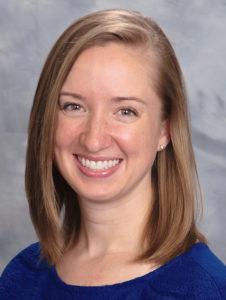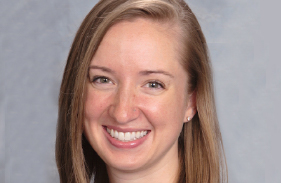In November, I had the unique opportunity to chat with Dr. Kelli M. McEntee, an obstetrician-gynecologist completing a minimally invasive gynecologic surgical fellowship at the Virginia Mason Medical Center in Seattle, WA. A core focus of our discussion centered around her drive to reduce opioid consumption in women undergoing gynecological procedures. Our conversation is summarized below:
Tell us about yourself – what is your background and what sparked your interest in acute pain management?
I am originally from the Pacific Northwest and went to the University of Washington, where I majored in Neurobiology and minored in Spanish. After graduating, I worked for AmeriCorps for a year prior to attending medical school at my alma mater. Following medical school, I went to California to complete my obstetrics and gynecology residency at the University of California, Davis. I am now back in Seattle at the Virginia Mason Medical Center where I am completing a two-year fellowship in minimally invasive gynecologic surgery. The focus of this additional training is to become proficient at complex pelvic surgery using laparoscopic and robotic approaches for problems like large uterine fibroids or advanced endometriosis. Historically we completed gynecological surgeries, like hysterectomies, with large abdominal incisions which required long recovery times. With these advancements, we can help women recover faster and have fewer complications.
 Being a trainee in the medical system sparked my interest in acute pain management. I was an intern when I first started prescribing opioids, and I would often ask senior residents or attendings for guidance on the correct amount to prescribe. With no clear solution on the “right” amount, I started to ask myself, “How do we know how much to prescribe?” To answer that question, I conducted a literature review (in 2016). I was surprised to find no specific guidance on the amount of opioids needed to address pain for women after a gynecologic surgery. In fact, one of the papers revealed that patients undergoing general surgery took far fewer opioids than prescribed – resulting in leftover pills available for potential diversion. Understanding the significance of the opioid epidemic, I felt it was important to learn how many opioids women took following surgery so we could start prescribing based on research rather than relying on anecdotal knowledge passed down by traditional/historical behavior.
Being a trainee in the medical system sparked my interest in acute pain management. I was an intern when I first started prescribing opioids, and I would often ask senior residents or attendings for guidance on the correct amount to prescribe. With no clear solution on the “right” amount, I started to ask myself, “How do we know how much to prescribe?” To answer that question, I conducted a literature review (in 2016). I was surprised to find no specific guidance on the amount of opioids needed to address pain for women after a gynecologic surgery. In fact, one of the papers revealed that patients undergoing general surgery took far fewer opioids than prescribed – resulting in leftover pills available for potential diversion. Understanding the significance of the opioid epidemic, I felt it was important to learn how many opioids women took following surgery so we could start prescribing based on research rather than relying on anecdotal knowledge passed down by traditional/historical behavior.
Can you tell us a bit about your hospital?
I work at Virginia Mason Medical Center, which is a non-profit, medium sized hospital with 336 beds. The hospital has multiple sites; I work at the downtown Seattle location. We serve our local community, and care for a large referral network from more rural parts of the state as well as Alaska.
What patient populations do you serve?
I treat a broad range of women – including teenagers, patients of reproductive age and those in (and beyond) menopause. Our gynecology practice provides a broad spectrum of gynecological care as well ranging from birth control to cervical cancer screening. However, my subspecialty training focuses on the management of advanced endometriosis, chronic pelvic pain, large uterine fibroids and painful or abnormal periods.
What inspired your group to create a non-opioid perioperative pain management experience for patients?
In light of the serious side effects associated with opioids, ranging from constipation and nausea to addiction and dependence, there is a lot of pressure from medical societies to reduce opioid prescribing. In the absence of clinical guidelines, my colleagues and I simply work to “prescribe less.” As a surgeon, it is imperative that we help our patients manage postsurgical pain, but how do you know the right number of opioids to prescribe, if at all, when there are no guidelines? You really feel stuck between a rock and a hard place because you want to provide excellent pain control for patients, but you also fear overprescribing these medications. We must find an approach that is based on science.
At both UC Davis and Virginia Mason, we have worked to develop bundles of care to help manage pain while minimizing opioid use. When possible, we deploy a multi-modal approach, leveraging different types of medication such as non-opioids, acetaminophen and ibuprofen to address pain. Setting expectations before surgery is key, as patients should know that they will experience some pain but it should be tolerable. My colleagues and I utilize a standardized ERAS pathway, which includes maximizing non-opioid medications perioperatively. Then postoperatively, we focus on getting people on their feet and moving. Many patients are worried that moving around might harm their recovery or dislodge stitches, so we spend time working with them. In a study our team conducted, we found that pain didn’t drive opioid use, but it was the quantity of the prescription that did. Women used more opioids if they were prescribed more; or if the surgery was completed for a pain-related reason. Regardless, a clear set of expectations is necessary for good patient care.
What positive downstream affects have you seen since you implemented your program?
That’s a good question. Although we only monitored our patients for three weeks (the period beyond that point is an area of future studies), we did see that 1 in 5 women didn’t use any opioids after a hysterectomy, and that patients used less if they were prescribed less. These findings surprised many of my colleagues.
Given the data that our study found, as well as similar studies where patients consumed only half of their prescriptions on average, I think a lot of our surgeons are feeling the freedom to prescribe fewer opioids. One of the potential positive effects is that smaller prescriptions may lead to lower consumption. Additionally, more physicians are talking with their patients about the downsides of utilizing opioids. In my practice, this approach has been very well received by patients as they want to be careful about their own opioid use when they are aware of the potential risks and side effects.
What are the next steps/future directions?
The first is to conduct another study to test a risk-factor based algorithm for post-op opioid prescribing; this project is underway with my colleagues at UC Davis. We aren’t quite in a place where we can completely forgo the use of opioids, but we can risk stratify our patients to try and reduce the large quantities of excess opioids that are generated from prescriptions for postsurgical pain. The goal is to look at individual patients’ risk factors for pain. For example, some women have significant pain from certain gynecological conditions like endometriosis even before surgery – we have found that these patients may have more pain and need more pain medication after surgery. A risk-factor based model would provide different sizes of opioid prescriptions to women based on their risk factors, rather than the same size for everyone. For women without pre-existing pain, we may even be able to move toward an opioid-free pathway, especially if patients are motivated to do so. More to come!
Lastly, I hope that my future work can expand on my study at UC Davis by including an opioid-free arm. I acknowledge that surgeons may be nervous to take that approach, as none of us want a patient to be home without adequate pain relief, but opioid-free procedures have been successful at several academic institutions across the country. Even if we never find the “perfect” prescription size, I hope that patients and providers alike will keep discussing this important topic and will prioritize proper disposal of any unused opioids while we determine the best course to help and protect our patients.



